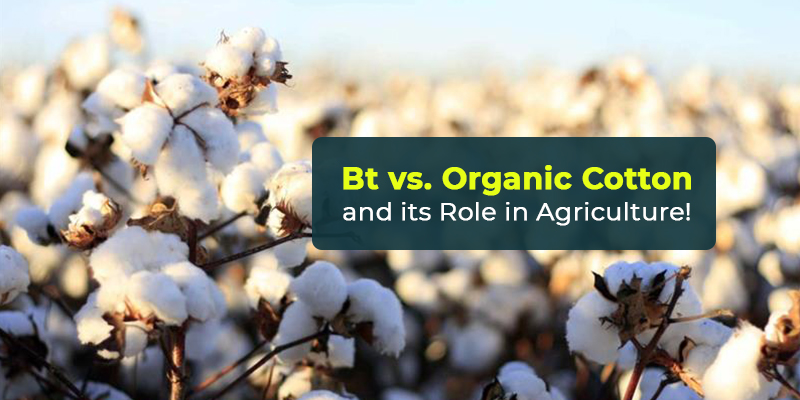India is the largest producer of cotton worldwide, which forms the essential element of the textile industry. The cotton plant is a shrub (warm-season) that is woody perennial and grown annually. Due to the fact that plants grow in different environments, it enables cotton farmers to select amongst varied cotton varieties and bred them for becoming productive in different cultural and environmental conditions, explain agriculture experts.
The Role of Cotton in Agriculture
Cotton (Gossypium sp.) is considered to be one of the biggest commercial crops that plays a vital economic role and is cultivated in almost nine million hectares in nine major states in India in various agro-climatic environments. Due to cotton production, 200 mandays/ha of jobs are secured, employing close to 60 million people for production, processing, and promotion. Although India has the biggest cotton covered area, the production is considerably low in its comparison (just 15.8 million bales).
Harvesting and Yield
The harvesting of cotton farming in Punjab and other states involves picking the bolls that are fully opened. The first picking of bolls must be done in the morning, especially when they are open 30-35%. The picking method involves picking the clean cotton first and then the affected one of the different varieties. After 15-20 days of the first picking, second picking should be done, dried in the sun for a few days (3-4), and stored at a dry and clean place.
Defining Bt Cotton
Bacillus thuringiensis (Bt) cotton is a transgenic crop that is insect-resistant and designed specifically for combating bollworm. This cotton type was created after genetically changing the cotton genome for microbial protein expression from the bacterium Bacillus thuringiensis.
Reasons for Bt Cotton’s Failure in India
Although BG-2 or Bollgard 2, the second generation cotton insecticidal technology of Monsanto was expected to protect the cotton crop from pink bollworm, the pest has become resistant to this trait’s produced toxins in India due to the following reasons:
Scientists often argue a lot, stating that Bt Cotton seeds do not suit the Monsoon conditions in India.
Unlike other cotton-producing countries, comprising open-pollinated varieties of cotton, Indian farmers simply go for hybrid varieties.
Bt Cotton Advantages
- It is able to repel the boll weevil larvae pest and other cotton plants harming larval insects, eliminating the pesticide need.
- Enhanced cotton yield due to efficient bollworms’ control of 3 types: Pink, Spotted, and American bollworms.
- Lepidoptera (Bollworms) insects are ‘crystalline endotoxic protein’ sensitive that is produced by Bt gene, leading to cotton protection against bollworms.
- Minimum use of insecticide in the Bt cotton cultivation constituting bollworms as the biggest pests.
- Reduced cultivation cost (with respect to seed cost against insecticide cost).
- A decrease in predators and es that help in bollworms’ control by feeding on bollworm eggs and larvae.
- Zero health hazards due to rare insecticides’ use.
Bt Cotton Disadvantages
- No idea of the consequences of BT gene insertion into the pool of cotton genes.
- Due to the fact that it destroys entire larval insects, a lot of chances exist for the killing of beneficial caterpillars.
- It is a health hazard to mankind and other species since it poisons the groundwater.
Defining Organic Cotton
Organic cotton is produced using seeds that are non-GMO (genetically modified) and without using any synthetic chemical (fertilizer and pesticide). This type of farming is less likely to add to global warming, eutrophication, and acidification.
Organic Cotton Advantages
- Environment-friendly
- Reduced synthetic chemical use
- Reduced nitrogen fertilizers, pesticides
- Reduced water pollution and synthetic chemical in sources of freshwater
- Reduced air pollution
- Enhanced dying, bleaching, and production
- Natural and cleaner cottonseed
- Reduced soil contamination and improved soil health
- Reduced effect on wildlife/ecosystems
- Reduced mono cultural crops due to superior crop diversity
- Reduced health hazards for workers
- Improved cottonseed oil quality, including animal feed’s cottonseed cake
Organic Cotton Disadvantages
- More use of the resources
- Reduced yield, efficiency, and revenue
- Failure to meet demand
- Increased greenhouse gas emissions at times
- More time and labor sensitive
- Lack of protection and subsidies
- Sluggish conversion/certification process
- More costly to produce/sell
Conclusion
So, this provides us with a clear picture about the merits and demerits associated with both Bt Cotton and Organic Cotton production. There is no denying Bt Cotton is fast becoming a favorite amongst farmers worldwide but it will take longer in India to become one. Irrespective of what cotton farming method you choose, you must be very clear about its execution.
In case you are doubtful regarding your chosen method type or have some other agricultural concerns, feel free to get your issues resolved through the expert team of Apni kheti by visiting the website or downloading the Apni kheti app!
For more information about Agriculture and Livestock, download Apni Kheti app – Android, iPhone





